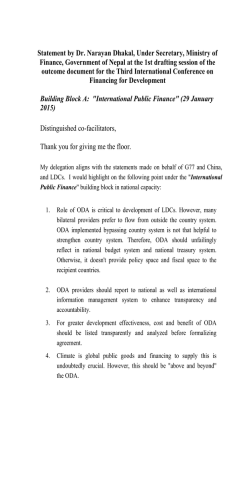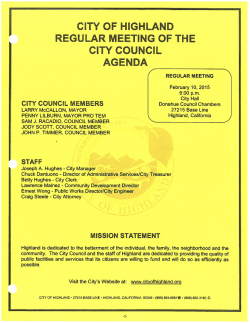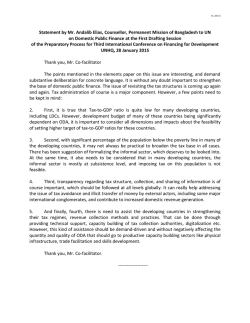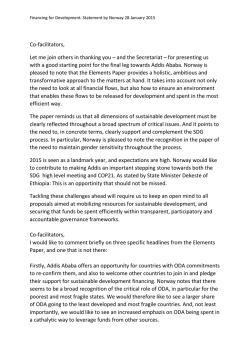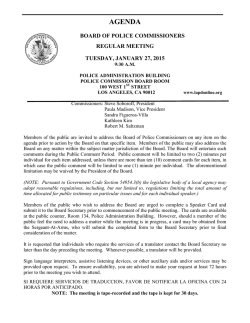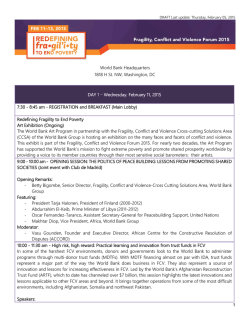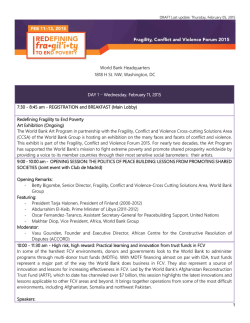
BRIEFING NOTE - International Alert
BRIEFING NOTE Fragile and conflict-affected states: the new norm in development finance recommendations for negotiators There has been limited focus in Financing for Development (FfD) negotiations on issues related to Fragile and conflict-affected States (FCAS). The emphasis has been placed on ‘source’ and ‘quantum’ of finance rather than ‘how’ and ‘where’ it is delivered. In this note International Alert analyses, through applying an FCAS lens, the January 2015 Preparatory Process Elements paper (‘the Paper’) to coincide with the first drafting session on 27-29 January 2015. It provides recommendations on how FfD negotiations might better reflect the particular needs of this group of states that will grow to represent the mainstay of international efforts to alleviate extreme poverty. A summary of this document is available at www.international-alert.org Context – why a focus on FCAS? The centre of gravity of global poverty has shifted and will continue to shift. It is estimated by the OECD that in 2015 half of the World’s people surviving on less than 1.25 dollars a day will be found in fragile situations. This figure will climb to around 75 per cent by 2030. So for finance directed at reaching the poorest, delivering in fragile and conflict environments will be the new norm. Further complicating this new reality is the fact that while most countries in fragile situations were lowincome a decade ago, today almost half are middle income 1. What makes increasing attention on FCAS so urgent in the FfD process is that it was this category of states that made the least progress against the MDGs. The majority of MDGs will not be met in fragile countries and six of the seven states who will not meet any of the MDGs at all are FCAS. But more development finance does not correlate to more peace. To reduce the likelihood that such states will be left behind again we must increasingly tailor the way finance is mobilised and delivered in such contexts. FCAS have often faced the greatest challenges in mobilising finance. Fragile states struggle to attract FDI, with three-quarters of FDI to fragile states going to just seven countries, all resource rich. Trade deficits outweigh new FDI inflows two to one and about half of fragile states are expected to see a drop in programmable aid between 2012 and 2015 despite ODA remaining their largest inflow. FCAS are likely to lose more in illicit outflows than they receive in aid. 1 OCED, ‘Fragile States 2013: Resource and Trends in a shifting world’ page 11 1 The ability to mobilise finance and the effectiveness of its implementation are highly affected by the presence of violence and conflict. Indeed, conflict, whether open conflict or criminal violence undermines and reverses finance mobilisation. The experiences of Ukraine, Syria and Central African Republic attest to this. The average cost of a civil war is equivalent to more than 30 years of GDP growth, meaning far less domestic resources available to promote development. It also acts as a significant deterrent for Foreign Direct Investment (FDI) apart from that attracted by war economies. FCAS are also prone to relapse into conflict. Conversely, investment in peacebuilding and development that addresses the underlying drivers of conflict (e.g. aiding reconciliation programmes) makes financial investments more sustainable, effective and durable helping to avoid future conflicts and building resilience against destabilising shocks. It is often the case that responses to insecurity follow a train and equip model. Serious and durable solutions to the challenges facing FCAS will need to go far beyond this approach to address the causal social tensions and fractures that such societies face with a focus on people’s security. Finance also interacts with the context. The way financing for development is delivered can be a force for stability but it can also have negative, albeit unintended, consequences. Taking a conflictsensitive approach can help mitigate the later. This means, based on a strong understanding of the local context and drivers of conflict, adapting the way that finance is mobilised and delivered. The need for such an approach applies irrespective of the source of finance – traditional and nontraditional donors, multilateral, national public, international or domestic private. Indeed, large influxes of money can in some circumstances be counterproductive, reinforcing grievances such as those around corruption and inequality unless carefully adapted to the political, security and development context. Flows of finance can also further entrench the structural factors such as inequality that drive conflict. Increasingly it is becoming clearer that inclusive political settlements and sufficient levels of reconciliation are required before large sums of finance are directed towards statebuilding. Beyond making finance conflict-sensitive, the way in which it is mobilised and applied has great potential to enhance peace and stability whether that is through national development and finance strategies or through the individual and collective efforts and actions of international investors or domestic enterprise. Overall, taken together, it represents an opportunity to ‘promote peace conducive economies’. These are economies which are conducive not just to prosperity but also to sustaining peace. In other words an economy which motivates people to act peacefully, resolving their conflicts without violence, and in which the presence of positive peace enables economic improvement in a virtuous circle. This reflects the concept that lies at the heart of the proposed SDG 16 – that peace and security is a pre-requisite to development, growth and prosperity and that these again, reinforce peace. A basis for negotiation? The challenge for those negotiating the next generation of financing commitments will be recognising the degree to which FCAS will influence effective implementation. As with most UN processes, negotiations build upon what has gone before – in this case the 2002 Monterrey consensus and 2008 Doha Declaration. We know much more now about the challenges of operating in FCAS and their 2 specific needs related to finance than we did when Monterrey was concluded. Indeed, Monterrey did not consider FCAS at all. Doha recognised FCAS as a class of states requiring attention but did not articulate a way forward. As such, the negotiation base for the current round of discussions is insufficient to reflect the realities articulated above and some innovation is required. While the Intergovernmental Committee of Experts report faced the same challenges in addressing issues related to FCAS it did usefully reaffirm that financing remains ‘ rooted in the principles expressed in the…United Nations Millennium Declaration ’ which includes ‘peaceful and inclusive societies’2. This recognition highlights that the promotion of peaceful societies should lie at the core of our ambitions when considering the mobilisation of the resources designed to implement the SDGs. This language could provide a useful complement to the existing FfD framework as negotiations are taken forward. Elements paper narrative In the Elements paper there has been a clear attempt to recognise FCAS as requiring special consideration. It notes that ‘additional international public and private finance flows are needed in …conflict-affected countries’ and that shocks, including conflict ‘cost billions of dollars to address and threaten to undo all we have achieved on development ’. It does also recognise the continuing importance of ODA to FCAS. But in other ways it underplays the significance of FCAS in the overall financing narrative (as the new norm) and particularly that of peace and stability. For example, while peace and stability are prerequisites for finance and investment, it is not listed amongst the factors of an enabling environment3. Making this link is the first step. Building on this would be moving beyond acknowledging ‘special needs’ of FCAS to acknowledging a need for an adapted way of working or ‘conflict sensitive financing’. This means not just avoiding harm but also making a positive contribution to peace through addressing the underlying drivers of conflict. Indeed, policies to mobilise finance including national finance strategies need, where related to FCAS, to integrate peacebuilding as resources are intimately intertwined with both conflict and stability. Thirdly, drawing a link with overall effectiveness, given most of the World’s poor will increasingly be concentrated in fragile states, is essential. This tailoring pairs well with the second of the Paper’s four overall policy ideas, ‘matching the financing flow with appropriate needs and uses’. 4 A conflict-sensitive approach: is based on a strong understanding of the local context and drivers of conflict and adapting the way that finance is mobilised and delivered. This is not just avoiding harm but also making a positive contribution to peace through addressing the drivers of conflict and strengthening the drivers of peace. 2 ‘UN Committee of Experts Report’ PP 18 Page 4 Elements paper page 1 4 Elements Paper Policy ideas Annex page (i) 3 3 1.1 Recommendation: In recognising the special circumstances of FCAS highlight the need to adapt the way finance is mobilised and delivered by applying a conflict-sensitive approach that both avoids unintended consequences and reinforcing factors for peace 1.1.1 Include a dedicated section in the outcomes document on FCAS given patterns of poverty and the impact fragility and conflict has on mobilising finance 1.2 Recommendation: Recognise the need to address the drivers of conflict not just technical capacity constraints to promote finance mobilisation 1.3 Recommendation: Recognise the promotion of peace as a dimension of the effectiveness, sustainability and quality of finance 1.4 Recommendation: Include peaceful societies amongst the list of environmental enablers for finance and acknowledge the need to look at creative financing modalities where other enablers remain underdeveloped 1.5 Recommendation: Cite the Peacebuilding and State building Goals linked to the New Deal as frameworks to promote effective development finance in FCAS Some sections of the paper only reference LDCs despite the issues having particular resonance for fragile states. This suggests FCAS are being conflated with LDCs, masking the reality that around half of all FCAS are actually MICs5. There is still further diversity amongst this grouping. Conflict can also effect otherwise stable middle income countries, generally at a sub-national level (e.g. Thailand, Philippines, Indonesia) as well as Middle Income Fragile States (MIFS) (e.g. Pakistan, Nigeria, PNG, Libya). Criminal orientated violence such as that experienced by Mexico and other Latin American states also requires attention. Overlooking this reality is problematic as otherwise stable MICs and MIFS, require different forms of financing and support than Low Income Fragile States. For example, ODA is likely to be increasingly less relevant to MIFS. Dependence on ODA though will not diminish across the board for this group. Those fragile states that have attained MIFS status have often done so on the back of a narrow set of finance streams, particularly extractives resources (e.g. Papua New Guinea, Nigeria), and have lacked either the will or capacity to translate such growth into addressing the significant levels of poverty, inequality and insecurity that persist within their borders. 1.6 Recommendation: Distinguish between LDCs and FCAS and between Middle Income Fragile States (MIFS) and Low income fragile states when considering needs and modalities While the Paper considers and links sustainable development to financing and investment it does not give specific attention to direct funding for peacebuilding. In the longer term this is necessary to sustain an environment conducive to investment, ensure the effectiveness and sustainability of finance and avoid ‘shocks’ such as relapses into conflict that radically reverse finance flows and growth trajectories. Financing dedicated peacebuilding alongside other national priorities is therefore one means to promote financial resilience or sustainability. It also boosts investor confidence that their investments will be able to avoid conflict or ride out periods of decreased stability. 5 OCED, ‘Fragile States 2013: Resource and Trends in a shifting world’ page 11 4 Currently and increasingly, peacebuilding funding is being directed at the point of crisis. This is too late in the context of safeguarding economic investments and maintaining a climate for new investment. Failing to address drivers of conflict ‘up-stream’ whether political, social or economic also costs lives and erodes social cohesion, human and economic capital for generations. This issue was specifically identified by the OECD as a key gap in the financing agenda in its 2014 Development Cooperation Report: mobilising Resources for Sustainable development . It states that peace and security are ‘key, if underappreciated prerequisites for sustainable development’ 6. It also highlights that the Peacebuilding and Statebuilding Goals agreed by 41 members of the New Deal for Engagement in Fragile state have not been fully matched with funding yet. 1.7 Recommendation: Give specific reference to the need to fund peacebuilding initiatives to enable investor confidence, avoid future shocks, promote sustainable investments and effectiveness. In summary, this translates into the following macro policy imperatives, including: The need to acknowledge working in FCAS environments will represent the mainstay of financing efforts to address extreme poverty for the foreseeable future; The need to tailor and adapt financing modalities to Fragile and conflict-affected Situations (recognising things take longer and are more complex and more risky), including as between MIFS and Low Income FCAS; The need to deliver finance in a conflict-sensitive manner across all forms of finance to avoid creating or exacerbating fragility and conflict; The need to try to ensure that finance and fiscal policy setting actively contributes to peace and stability; and The need to recognise that peace and stability will be crucial to effectiveness. Domestic public finance The Paper recognises that ‘administrative capacity to raise public revenue remains weak particularly in conflict-affected countries’7. Indeed, domestic revenue represented only 14 per cent of GDP of fragile states in 20118. There is a clear need to improve the way domestic finance is mobilised keeping in mind the challenges that some FCAS, particularly low income states, face in this respect. The way in which finance is managed at the national and subnational level is also important and can have a profound impact on peace and security. Instability, in turn reduces incentives for domestic savings and investment with populations focused on their immediate rather than long term future. In the Paper’s discussion on domestic financing it highlights that ‘effective use of resources must go hand in hand with their mobilisation’. As discussed earlier conflict-sensitive finance is essential to effectiveness. 6 OECD 2014 Development Cooperation Report: mobilising resources for sustainable development chapter 19 page 220 Elements paper page 3 8 OECD 2014 Development Cooperation Report: mobilising resources for sustainable development chapter 20 page 233 7 5 It goes on to state that ‘fiscal policies need to be consistent with macroeconomic stability, equitable growth, social transformation and sustainability’ noting that, ‘revenue/expenditure decisions are often not in line with sustainable development criteria’ and can sometimes have ‘negative consequences for inequality’9. As a policy idea the paper encourages the adoption of national sustainable development financing strategies or frameworks and the mainstreaming of sustainable development criteria in revenues and expenditures10. Fiscal policy and expenditure practices also need to be consistent with peacebuilding needs in FCAS contexts where development, economic and security are closely intertwined. The way that resources are disbursed can have a significant influence over local, regional and national stability. The right fiscal settings can also help revive or build the social contract between people and their state. In this respect national financing strategies suggested in both the Elements and Experts papers represent an opportunity to ensure that finance investments are peace conducive, conflict-sensitive and adapted to the local context. 2.1 Recommendation: Integrate peacebuilding along with sustainable development in National Finance Strategies to promote a peace conducive finance framework The paper notes that ‘Good governance’11 is important to sustainable development and reducing fragility and conflict. Governance, however, is just one of the many ingredients necessary to address fragility and mobilise finance. Indeed, technical solutions to governance problems, whether that is corruption, fiscal management or the rule of law will not automatically correlate to more peaceful and stable states. Instead it is important to address, through appropriate policies and supporting finance, the underlying drivers of conflict. This refers to the broader spectrum of social and political challenges as well as institutions beyond those of the state which contribute to or help break cycles of conflict that undermine prospects for sustainable development finance. In this respect it is important that policy ideas extend beyond, fighting corruption and promoting transparency 12. It should also be acknowledged that achieving improvements in things like governance can take decades in fragile and conflict-affected contexts i.e. beyond the envisaged fifteen year timeframe of both the SDGs and financing processes. Many states that experience conflict often also relapse setting back economic development and undermining financial investments. Measured expectations will be important. 2.2 Recommendation: Look beyond formal governance systems in FCAS to address underlying drivers of conflict in seeking to create an enabling environment for finance 2.2.1 Highlight the particular impact corruption has on FCAS noting that both technical and political economy solutions to tackle it are necessary There are nevertheless some areas where strong government institutions are essential in promoting peace and stability as an enabler for finance. There is an opportunity to ensure finance and investment regimes seek to avoid creating conflict with adequate environmental and social safeguards. This can range from regulation around extractive industries to the formation of special economic zones. Particular attention will need to be paid to the way the massive upswing in infrastructure investment is delivered given infrastructure’s role as a trigger of conflict in both fragile 9 Elements paper page 4 Elements paper Policy ideas page (i) 11 Elements paper page 4 12 Elements paper Policy ideas Annex page (ii) 10 6 states and more stable developing states. It is also possible to create incentives for investors to invest in a conflict-sensitive manner and reward actors who do so. 2.3 Recommendation: When creating an enabling environment for finance ensure that appropriate social and environmental safeguards are in place with capacity to uphold them 2.4 Recommendation: Create incentives for private sector actors to not only avoid the risk their actions will exacerbate conflict, but also actively to contribute to peace As with the Experts’ report the elements paper highlights the need to improve tax collection and administration. Generating sufficient revenue through taxation is a perennial problem for FCAS where systems are weak and often much of the economy is informal. The OECD identifies in its 2014 Development Cooperation Report, the need to improve tax collection in fragile states as one of its key recommendations. In certain cases, this can play an important role in catalysing and/or strengthening accountable state-society relations. It has been a particular challenge for resource rich states which governments, donors and international initiatives are increasingly trying to address. The OECD suggests that the level of taxes that a state can raise depends on all three dimensions of fragility – authority (notably territorial), capacity and legitimacy – all generally at deficit in fragile contexts13. This suggests the need for a more sophisticated approach to taxation in FCAS that goes beyond technical fixes. One of the Paper’s policy ideas is support to broaden the tax base, including formalising the informal sector14. Improving tax systems must however, be accompanied by improvements in service delivery and government accountability. States lacking a state-citizen contract, effectively taxing citizens without providing any recognisable benefits or services, can actually undermine state legitimacy and promote instability. Therefore, sequencing of tax reform is essential in FCAS. In other words there is no one-size-fits-all solution to tax reform. Illicit transfers are a particular challenge for FCAS. In some cases they are worth more than inflows of ODA. There are many examples of illicit financial flows feeding into and enabling conflict and violence. Illicit financial flows have funded rebel groups, terrorists, organised criminals and governments in places such as Nigeria, Cambodia and Myanmar, Liberia and Mexico. The Paper’s policy idea to enhance mechanisms to address tax evasion is welcome but consideration should be given to what more might be done (see Systemic issues section of this note). 2.5 Recommendation: Tailor and sequence tax reform in FCAS relative to the local social and political context As with the Experts report, the Elements Paper identifies finance from natural assets as a critical means through which to mobilise resources. The paper suggests that the ‘public share of earnings from resource extraction in resource-rich countries is often inadequate, inequitable and volatile’15. In its policy ideas it also emphasises the need to ‘ensure the public share of economic rents in resourcerich countries is equitable and stable’16. This is doubly the case in FCAS - one-in-four fragile states on the DAC list possess significant natural resources17. Added to this is the challenge of translating 13 OCED, ‘Fragile States 2013: Resource and Trends in a shifting world’ page 47 Elements Paper Policy ideas Annex page (i) 15 Elements paper page 4 16 Elements paper Policy ideas Annex page (i) 17 OCED, ‘Fragile States 2013: Resource and Trends in a shifting world’ page 12 14 7 such rents into sustainable development while managing the potential for local conflict appropriately. There are countless conflicts that relate to, were triggered by or are sustained through the exploitation of natural resources. The World Bank 18 noted in research on the subject that an otherwise typical country that has primary commodity exports around 25 percent of GDP has a 33 percent risk of conflict, but when such exports are only 10 percent of GDP, the risk drops to 11 percent. At the same time extractive revenues, when harnessed properly and in a way that manages the potential local drivers of conflict (such as displacement of populations, inequitable sharing of resources, etc.) can be highly beneficial to a countries path out of fragility and conflict. In this respect the paper could more strongly highlight the particular challenges of FCAS in managing natural resources. The paper presents some strong and constructive Policy ideas related to natural resources, including, strengthen government capacities to successfully participate in the extractives sector and promoting the establishment of commodity stabilization funds and encouraging countries to implement the Extractive Industries Transparency Initiative. It is important though, when establishing new systems and fostering an enabling environment for investment that appropriate safeguards and policies are in place that not only prevent instability but that help states maximise the rents received. Consideration should also be given, within this approach to strengthening civil society oversight of the extractive sectors. Further clarity around what strengthening government capacity actually means is also necessary. 2.6 Recommendation: Ensure that assistance for FCAS goes beyond capturing additional natural resource rents to support that helps translate this finance into sustainable peace and development outcomes 2.7 Recommendation: Ensure robust natural resources safeguard measures are put in place in developing an investment enabling environment including through enhancing civil society oversight of the sector The Elements Paper considers budgeting but devotes less attention than the Experts report 19 to budget processes and execution that take an inclusive approach to resourcing. This is however very important in FCAS, particularly where groups or regions experience economic and social exclusion and where an absence of infrastructure and services contributes to grievances that fuel conflict and in turn create barriers and disincentives for growth and development. For example, the relative marginalisation of the south of Sudan from oil-wealth, infrastructure development, social services and economic growth was a significant contributor to what was Africa’s longest civil war. 2.8 Recommendation: Promote inclusive budget and resource planning 18 19 World Bank, Natural Resources and Violent Conflict: Actions and options 2003 page 3 ‘UN Committee of Experts Report’ PP 70 Page 20 8 Domestic and international private finance Given private sector finance and investment will increasingly dwarf public international finance, especially in Middle Income Fragile States, an FCAS approach is even more important for private domestic and international finance. The three of the basic policy imperatives so far reflected remain relevant: The need to deliver finance in a conflict-sensitive manner to avoid creating or exacerbating conflict; The need to tailor and adapt financing modalities to FCAS contexts; and The need to take advantage of opportunities for finance and fiscal policy to actively promote peace and stability. The greatest disincentive for both domestic and international investors remains the presence of insecurity and conflict which generates higher risk to capital, human resources and promote political uncertainty and cost increases. Fragile states struggle to attract FDI, with three-quarters of FDI to fragile states going to just seven countries, all resource rich20. Overall, trade deficits outweigh new FDI inflows two to one 21. Conflict focuses individuals and communities on short terms needs rather than on longer term considerations which correlate to savings and investment. This is problematic as development at the very local level, and therefore in large sum overall development, is driven by households, communities and local business. With respect to business, in 2013 the UN Global Compact noted that ‘ peaceful and stable conditions…are necessary for the private sector to deliver economic and related social benefits integral to broad sustainable development’22. Therefore, in the first instance efforts must be put into addressing peace and instability as a precursor to improved investor confidence. Future financing must be encouraged and housed in a regulatory framework that avoids triggering new conflict or restarting old with adequate environmental and social safeguards. This can range from regulation around extractive industries to the formation of special economic zones. Particular attention will need to be paid to the way an upswing in infrastructure investment23 is delivered given infrastructure’s role as a trigger of conflict whether in fragile states or not.24 3.1 Recommendation: Reaffirm peace and stability as a prerequisite to attracting private sector investment 3.2 Recommendation: Pay particular attention to conflict-sensitive financing approaches in the scale up on infrastructure investments 20 OCED, ‘Fragile States 2013: Resource and Trends in a shifting world’ page 12 OCED, ‘Fragile States 2013: Resource and Trends in a shifting world’ page 45 22 UN Global Compact, Building the Post 2015 Business engagement architecture, 2013 page 17 23 Elements Paper Policy ideas page (iv) 24 ‘UN Committee of Experts Report’ PP 33 Page 8 ‘Infrastructure investment required will be in the order of $5-7 trillion’ 21 9 Other strategies also reinforce stability. The Paper gives attention in its Policy ideas 25 to shaping private sector behaviour and contributions to sustainable development. This of course should be extended to reinforcing peace and stability. Development-enhancing linkages between multinational enterprises and local production activities are important and also contribute to local stability. The Paper suggests providing incentives for companies to invest in sustainable development and this should be of course extended to the contribution they can make to peace and stability in FCAS contexts. It is important to recognise the positive contribution that the private sector can make to promoting peace. Ideas around implementing the UN’s Guiding Principles on Business and Human Rights and core labour standards are also move in the right direction. 3.3 Recommendation: Provide incentives for companies to invest in sustainable development AND actively contribute to peace and stability 3.4 Recommendation: Encourage private sector leadership in conflict-sensitive finance that focuses on avoiding conflict and contributing to peace, through continued development of good business practice and the development of global and national standards 3.4.1 Recommendation: Encourage the integration of peacebuilding alongside sustainable development in company strategies Reducing risks for private investment is considered in the policy ideas 26 but risks related to instability and conflict is not amongst them despite it being both a high risk and significant disincentive to business investment. In this respect addressing the underlying drivers of conflict and capitalising on drivers of peace is essential to promoting and emailing environment conducive to investment. 3.5 Recommendation: Consider conflict and violence amongst the key risks to business investment and development finance Building on the Secretary General’s December Post 2015 synthesis report, the Paper’s suggestion around revisiting safeguards for multilateral development banks 27 to ensure investments are aligned with sustainable development is welcome. This should be extended to how investments avoid conflict and support peace in the context of not only FCAS but developing countries more broadly. Reform is welcome where these enhance current provisions and increase protections. This is particularly pertinent for blending (e.g. IFC type arrangements). It notes that ‘blended finance and public private partnerships offer potential in many areas, but there are challenges in fair and effective implementation, and countries often lack capacity’.28 The policy idea related to strengthening the World Bank’s Multilateral Investment Guarantee Agency (MIGA) to enhance its risk mitigation mechanisms for sustainable development investments is welcome but this should be extended to IFC, IDA and IBRD funded investments as well. This should reinforce and complement the Bank’s reform efforts relating to its engagement with FCAS. 25 Elements Paper Policy ideas Annex page (iv) Elements Paper Policy ideas Annex page (iii) 27 Elements Paper page 5 28 Elements Paper page 6 26 10 3.5 Recommendation: Reaffirm the need to review and strengthen World Bank Group safeguard mechanisms as well as those of regional international financial institutions 3.7 Recommendation: Emphasise the importance of leveraging bi-lateral and multilateral blended finance for peace positive outcomes Many of the issues that apply to multilateral blended finance also apply to PPPs 29. In this respect the Paper’s recommendations are welcome in so far as they encourage greater transparency, accountability, equity, fairness and sustainability but there needs to be increased clarity around the application of safeguards in such situations. One of the key policy ideas falling under this banner of private sector investment is supporting remittances including lower transaction costs. This has particular relevance for FCAS where remittances represent one of the few sources of external finance. The DAC in its 2014 Development Report ‘Mobilising resources for sustainable development’30 singles out remittances as an important source of development for FCAS. It highlights that remittances provide relatively more stable sources of income than most other external flows.31 3.8 Recommendation: Reaffirm a commitment to reduce the transaction costs of remittances Finally the paper, in its policy ideas32, encourages efforts to achieve financial inclusion. It suggests strengthen financial inclusion strategies at the national level. As suggested previously with fiscal policy, it is important, when dealing with FCAS to ensure that this integrates a peacebuilding approach. Moreover, it should not just be geared towards gender inclusivity but also ethnic and religious minorities where these represents fault lines in a society. 3.9 Recommendation: ensure that financial inclusion relates to both gender but also ethnic, religious and other minorities International public finance As with the other forms of finance it is essential that international public finance is appropriately adapted to fragile and conflict contexts. This means ensuring that a conflict-sensitive approach to investments is applied that avoids harm while seeking to actively contribute to peace. There is a significant level of guidance and literature related to international public finance which gives guidance as to how to do this effectively such as, the OECD DAC Principles for Good International Engagement in Fragile States and Situations and the more recent State Building and Peace Building Goals. 29 Elements Paper Policy ideas Annex page (v) 2014 Development Report ‘Mobilising resources for sustainable development’ Chapter 20 Backing recovery in fragile states 31 OCED, ‘Fragile States 2013: Resource and Trends in a shifting world’ page 12 32 Elements Paper Policy ideas Annex page (iii) 30 11 Many donor agencies are working to integrate such approaches into their operational models. This is in part inspired by the reality that the focus of aid programs was increasingly concentrated in FCAS but also based on the understanding that it is key to effectiveness and sustainability. 4.1 Recommendation: Donors should recommit to ensuring that their assistance is conflict-sensitive in not only avoiding creating conflict but also actively seeking to build peace The paper notes that ODA will remain essential for countries emerging from conflict33. In its policy ideas, though, reference is only made to increasing ODA allocation to LDCs and other vulnerable countries’34. As suggested previously it is important to be specific given FCAS straddle both LDCs and MICs. Middle income status is an increasingly poor indicator of poverty reduction, equitable growth and security and stability. As such, in deciding eligibility for grants and concessional loans there needs to be a differentiation between stable Middle Income Countries, Middle Income Fragile States and Low Income Countries. In this respect, the Paper calls for a review of graduation criteria and the limits on access to finance for lower middle income countries35. It further calls for ‘enhancing access to concessional and nonconcessional international public finance’, with ‘non-IDA-eligible MICs remaining eligible to receive grants in special situations or to address special priority challenges ’36. MIFS clearly fall into this category and this should be specifically acknowledged. MIFS may have income at a national level but through lack of will or capacity this is not being translated into poverty alleviation, peace and stability. 4.2 Recommendations: Endorse the revision of finance eligibility criteria, including broaden the indicators used to assess eligibility to issues including numbers of poor and the presence of conflict. Low income fragile states remain highly dependent on ODA, representing their biggest financial inflow. This reality is however set against an expected drop in aid to such states between 2012 and 201537. It is part a consequence of the financial crisis and austerity measures but also a reflection of a trend towards funding immediate crises rather than longer term investments which represent a more preventative approach. OECD donor investment in Public Financial Management and domestic revenue raising is also currently declining in FCAS – a trajectory that needs to be stabilised. 4.3 Recommendation: Recognise that low income fragile states remain highly dependent on ODA the international community should renew its commitment to properly financing low income FCAS 4.3.1 Recognise that ODA can play a role as an enabler for other forms of finance The Policy ideas also call on states to increase the effectiveness of aid 38 and development cooperation. This is where specific reference should be made to conflict-sensitive approaches given the increasing concentration of those living in poverty in FCAS. Furthermore, international architecture related to operating in FCAS should be referenced, including the Peacebuilding and Statebuilding Goals as a means of enhancing development effectiveness. 33 Elements Paper page 6 Elements Paper Policy ideas Annex page (v) 35 Elements Paper Policy ideas Annex page (vi) 36 Elements Paper Policy ideas Annex page (vi) 37 OCED, ‘Ensuring fragile states are not left behind’ 2013 Factsheet 38 Elements Paper Policy ideas Annex page (vi) 34 12 4.4 Recommendation: Recognise the importance of a conflict-sensitive approach to effectiveness in a poverty landscape increasingly dominated by FCAS. Identify the New Deal and Peacebuilding and State building Goals as means lens through which to approach more effective aid to FCAS South-south cooperation39 presents an opportunity for improved development effectiveness. This takes the shape of collaboration between FCAS (for example the g7+) as well as between FCAS and those countries which have successfully escaped conflict. In this way such cooperation goes beyond the sharing of resources to make a contribution to effectiveness more broadly. The Paper notes that climate change resources are increasingly directed towards MICs rather than LICs. While climate change is a threat to all states and their sustainable development it has particular consequences for FCAS creating extra pressure on already limited resources increasing the chances of conflict. In this respect FCAS should be differentiated from LDCs. Trade As with finance broadly, trade can be an important contributor to peace. Conversely, conflict impairs international, interregional and internal trade through unsafe frontiers and transport routes and the degradation of infrastructure as well as through generating increased investment risk. The Paper highlights that Trade ‘requires a national policy framework that enables domestic firms and workers to capture equitable shares of the gains from trade, while ensuring environmentally sound and socially beneficial production’40. In the context of trade the same considerations for encouraging FDI and private sector domestic and international investment should apply in the context of FCAS. Special consideration should also be given to the liberalisation of subsidies and tariffs. The sudden removal of subsidies, e.g. on fuel, has led to instability and violence in FCAS (e.g. Yemen) as well as created social tensions in more stable countries when not dealt with sensitively. Such efforts should be sequenced with the growth and competitiveness of domestic sectors and balanced against improving safety nets for the poorest. Trade shocks, particularly in commodities, is a particular challenge for FCAS reliant on extractives income. The Paper’s suggestion of increasingly implementing national stabilisation funds is sensible in this respect. 5.1 Recommendation: Sequence trade reform carefully in FCAS to take account of the social and political context Systemic issues The realm of ‘Systemic issues’ tends to focus on the international financial system and institutions but does acknowledge climate change, disasters and other environmental challenges as posing 39 40 Elements Paper Policy ideas Annex page (vi) Elements Paper page 7 13 additional systemic risks to sustainable development and poverty eradication 41. Fragility and Conflict need to be represented equally. Systemic issues lie in local capacity to manage conflict peacefully and the international community’s capacity to deal with challenges upstream before situations degenerate into crisis. 6.1 Recommendation: Recognise the need for the international architecture responsible for development, peace and security to increasingly prioritise upstream interventions that support peace and promote environments conducive to investment The creation of new financial institutions, such as the BRICs bank and China Infrastructure Bank offer opportunities but they will nevertheless face same challenges and carry the same responsibilities in FCAS contexts. There is however an opportunity to integrate good practice early on to avoid the challenges that traditional institutions such as the UN, World Bank Group and regional development banks face. This should be encouraged. 6.2 Recommendation: Recognise that new and emerging financiers bring with them new and sometimes innovative means of finance mobilisation and delivery and that they should be encouraged to enter the dialogue around conflict-sensitive financing Probably one of the more innovative policy ideas in the Paper is using a broader metric of well-being than GDP as a sustainable development indictor. This makes absolute sense in the context of the earlier discussion around Middle Income Fragile States as well as more stable states where national GDP masks subnational conflict and poverty. Such a reconceptualization should include indicators related to fragility and conflict, peace and stability. 6.3 Recommendation: Affirm the need to revisit GDP as a measure of poverty reduction. Integrate fragility and conflict in a more diverse set of indicators It is also important that wealthier countries look more seriously at assessing their domestic policies for potential risks to fragile states, ranging from arms sales, financial regulation and moneylaundering, anti-bribery and anti-corruption legislation, tax havens, extractive industries and narcotics policies. 6.4 Recommendation: OECD nations should assess and act upon domestic policies that undermine resources mobilisation in FCAS Monitoring, data and follow-up42 Better data is needed on non-ODA finance in FCAS. FDI data is based on global estimates from the World Bank and in many cases cannot be disaggregated by sector. ODA is based on estimates from the OECD-DAC membership and not rising powers, while only 15 of 50 countries on the fragile states list report on domestic revenues. It is unclear how much finance is lost through illicit financial flows. 41 42 Elements Paper Page 10 Details and statistics on data and monitoring provided by the Centre for International Cooperation 14 Once the post-2015 targets take shape under the SDGs there will be a need to measure the finance which is set against them including for proposed SDG 16 on peaceful societies. The Paper highlights the challenge of drawing statistical links between private investment and sustainable development43. The same could be said of private investment and peace and security – a factor critical to both finance and development. 6.1 Recommendation: improve relevant institutional collection systems while supporting national governments to more effectively fill data gaps related to FCAS. Conclusion Recognising that over the next 10-15 years extreme poverty will become concentrated in conflictaffected situations44, whether in low income countries or middle income countries, identification of conflict as an influential contextual factor is as essential as recognising climate change and environmental degradation. Does the current FfD agenda reflect this? Not yet, but it can. As it stands, both the general narrative and individual building blocks underplay the significance of Fragile and conflict-affected States to the future of development financing. Fragility and conflict’s relationship to the effectiveness agenda, as well as the contribution peace and security makes to the enabling environment for finance, needs to be highlighted. The agenda needs to identify and apply a different approach to mobilising and delivering finance in FCAS while ensuring appropriate institutional safeguards are in place to facilitate and support effective finance and promote peace and stability. Consideration needs to be given to integrating peace considerations into national fiscal strategies while looking for opportunities for individual investments to enhance peace. The private sector is demonstrating a growing commitment to conflict-sensitive finance evidenced by such initiatives as the global compact and the Voluntary Principles. This can be further reinforced with incentives. In FCAS contexts resourcing peacebuilding efforts will make an important contribution to building and sustaining the conditions for finance mobilisation. Ultimately, recognising these considerations and applying the approaches to fragility and conflict outlined should be regarded as the key deliverables for FCAS out of the FfD process. January 2015 About International Alert International Alert helps people find peaceful solutions to conflict. We work in more than 25 countries around the world and are one of the world’s leading peacebuilding organisations, with nearly 30 years of experience laying the foundations for peace. We work with local people around the world to help them build peace and we advise governments, organisations and companies on how to support peace. We focus on issues that influence peace, including governance, economics, gender relations, social development, climate change, and the role of businesses and international organisations in high-risk places. www.international-alert.org 43 44 Elements Paper Page 11 OCED, ‘Ensuring fragile states are not left behind’ 2013 Factsheet 15
© Copyright 2026
